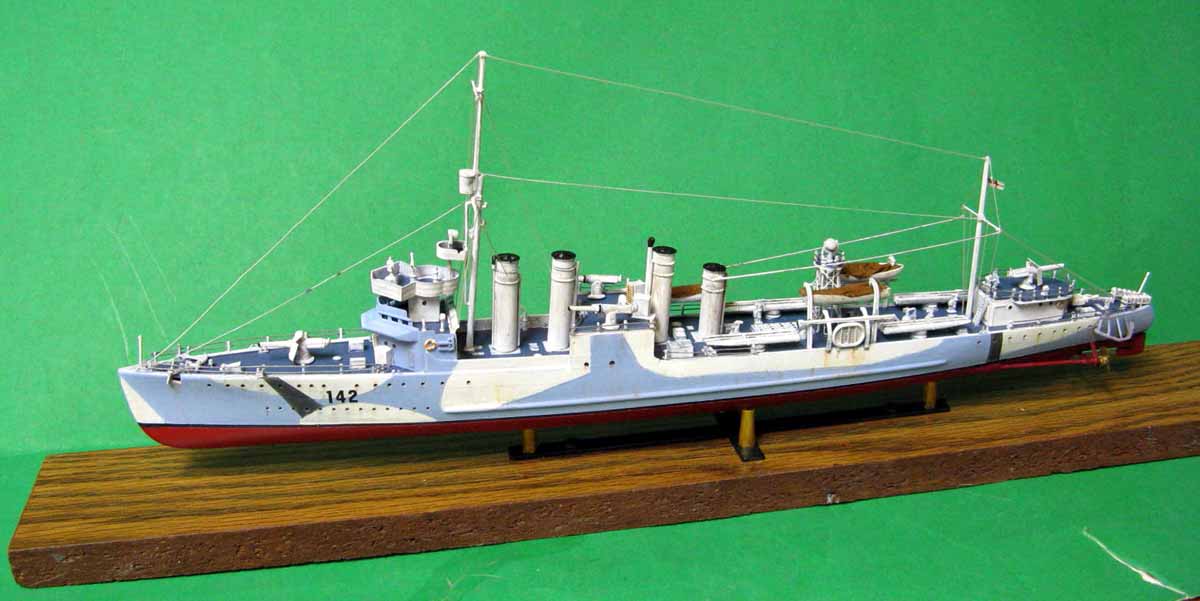by Paul Helfrich

1/240 HMS Campbeltown (Revell Germany)

HMS Campbeltown was originally the Wickes-class destroyer USS Buchanan, DD-131. She was commissioned in 1919 and transferred to the UK as part of the “Destroyers for Bases” deal between the US and Britain in 1940. In exchange for 50 aging “four-piper” destroyers like the Buchanan/Campbeltown (obsolete for fleet duties, but still useful as convoy escorts) for the Royal and Royal Canadian navies, the US got basing rights in the Caribbean and Newfoundland .
HMS Campbeltown is one of the most well-known of the traded ships, as she was famously expended as a floating bomb in the “Operation Chariot” raid by British commandos on the St. Nazaire docks in March of 1942. The purpose of the raid was to deny the use of the St. Nazaire dry dock to heavy German units such as the battleship Tirpitz.
Revell's 1/240 four-piper destroyer kit has been around since the 1960s and has been issued many times as the USS Ward, the USS Buchanan, and the HMS Campbeltown. It's basically the same kit every time it comes out, except for the decals. However, even though the decal sheet for this reissue includes the White Ensign of the Royal Navy, the hull number included is still the 131 (in US-style lettering) that goes with USS Buchanan.
In my opinion, this is one of the best of the older ship kits. Unlike some Revell kits of similar vintage, it's accurate below the waterline, with shafts and screws as well as a rudder. And unlike many kits of the era, rather than heavy molded railings, it has stanchions that may be rigged with thread. Other nice features include open scuttles and relatively good detail on the decks and bulkheads.
Before the Campbeltown was turned into WWII's version of the Trojan Horse, she did escort duty on the Western Approaches and wore an attractive camouflage scheme of white and light blue. I opted to go with this look for the model, a very different one from how she appeared in US service.
The only part of the kit that is really unacceptable for use, in my opinion, is the searchlight tower. For some reason, the detail is molded on the inside of the parts, and the sides that face the outside world are flat and very unrealistic. I replaced these parts with a structure I scratch built from brass rod and stretched sprue. It's not completely accurate, but it looks better than the kit parts. I also added splinter shields made from card stock to the bow and stern guns, to match how they appeared while in British service. I liked the covers on the ship's boats that are shown in the box art, so I fabricated those from paper towels.
The railings were rigged with thread; other rigging was done with stretched sprue. Weathering was done with pastels, and the kit's hull number was replaced with decals from my spares box to match how she appeared in British service.
As noted, HMS Campbeltown's great claim to fame was her role in the St. Nazaire raid. However, she was heavily modified prior to that operation, specifically, altered to resemble a German torpedo boat so as to help her get as far into the harbor as possible without alerting the enemy. It would take a lot of scratch building to alter this kit in such a way as to yield a model of Campbeltown as she appeared in the raid.